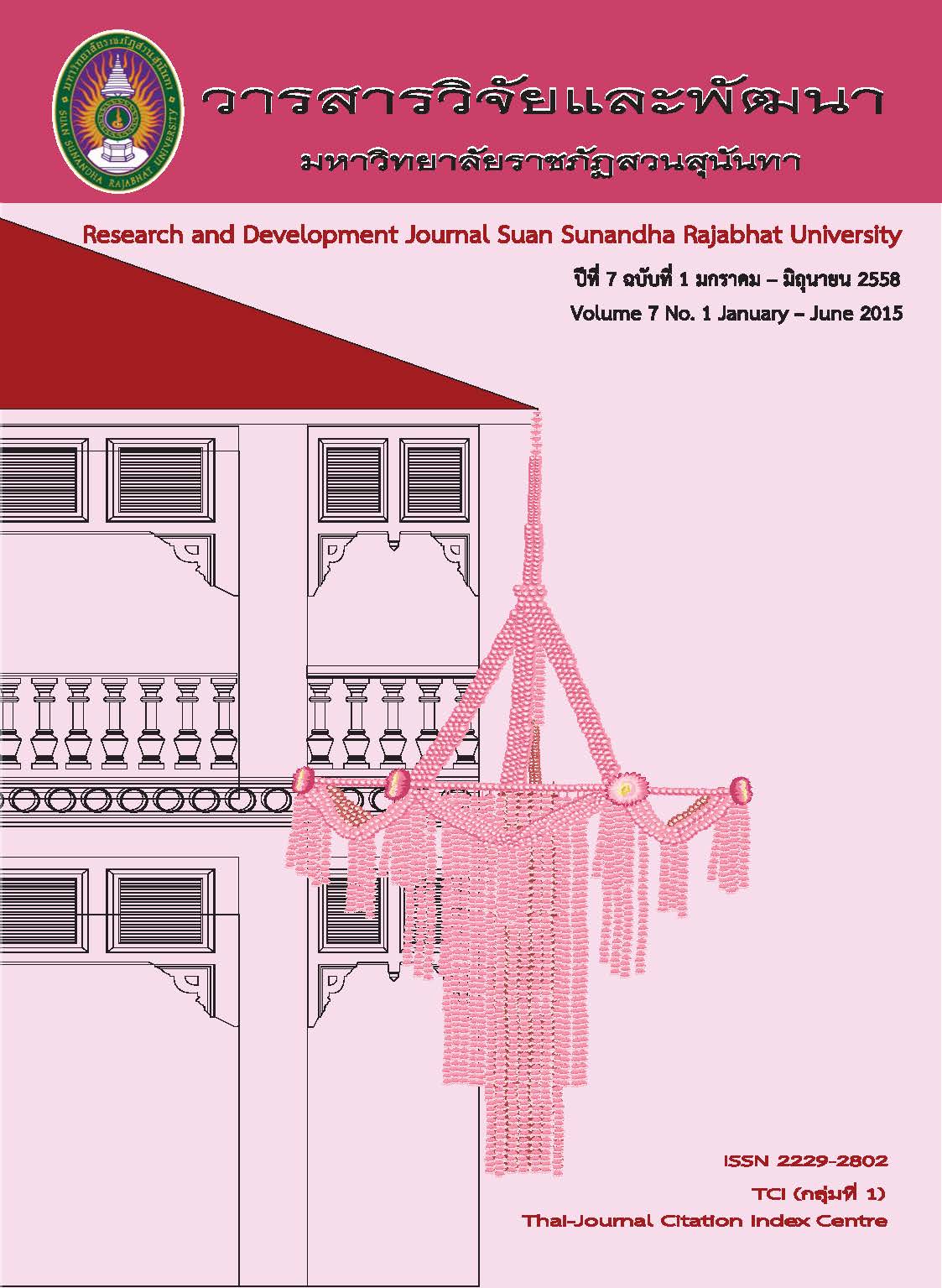ผลกระทบของเงินโอนต่อการเจริญเติบโตทางเศรษฐกิจในกลุ่มประเทศอาเซียน
DOI:
https://doi.org/10.53848/irdssru.v7i1.214574คำสำคัญ:
เงินโอน, การเจริญเติบโตทางเศรษฐกิจ, การวิเคราะห์ข้อมูลพาแนล, เออาร์ดีแอลบทคัดย่อ
การศึกษาครั้งนี้มีวัตถุประสงค์เพื่อศึกษาผลกระทบของเงินโอนต่อการเจริญเติบโตทางเศรษฐกิจในกลุ่มประเทศอาเซียน ทั้งทางตรงและทางอ้อมผ่าน ช่องทางการพัฒนาทางการเงิน ทุนกายภาพและทุนมนุษย์ โดยใช้ข้อมูลกลุ่มประเทศอาเซียน 8 ประเทศ ในช่วงปี 1993-2013 แบบจำลองที่ใช้พัฒนามาจากแบบจำลองการเจริญเติบโตของนีโอคลาสสิค ทำการประมาณแบบจำลองเป็นรายประเทศโดยใช้วิธีเออาร์ดีแอล และศึกษาทั้งภูมิภาคโดยวิธีพาแนลโคอินทีเกรชัน จากการศึกษาพบว่าเงินโอนส่งผลกระทบทางด้านบวกต่อการเจริญเติบโตทางเศรษฐกิจทั้งทางตรงและทางอ้อม เมื่อพิจารณาเป็นรายประเทศ พบว่าผลของแต่ละประเทศในอาเซียนค่อนข้างแตกต่างกัน โดยมีประเทศฟิลิปปินส์เป็นประเทศหลักที่ได้รับเงินโอน ในขณะที่ ประเทศไทย เวียดนามและอินโดนีเซีย เงินโอนส่งผลต่อการเจริญเติบโตทางเศรษฐกิจอย่างมีนัยสำคัญ ส่วนลาว เมียนมาร์และกัมพูชา เงินโอนส่งผลต่อการเจริญเติบโตค่อนข้างน้อยเนื่องจากความไม่มีประสิทธิภาพในภาคการเงิน
เอกสารอ้างอิง
นรินทร์ โอฬารกิจอนันต์. (2556). อะไรทำให้ประเทศเจริญ (ทางวัตถุ). สืบค้นเมื่อ 13 มกราคม 2558. จาก http://www.coziplace.com/ archives/2354
ปราการ สมร่าง. (2553). ความสัมพันธ์ระหว่างการลงทุนโดยตรงจากต่างประเทศกับตัวแปรทางเศรษฐกิจในกลุ่มประเทศ จี20 โดยวิธีเออาร์ดีแอล. (การค้นคว้าอิสระเศรษฐศาสตร์มหาบัณฑิต, มหาวิทยาลัยเชียงใหม่)
มติชนออนไลน์. (2556, 3 ตุลาคม). เวิลด์แบงก์ เผยแรงงานต่างด้าวส่งเงินกลับประเทศมหาศาล ปีนึง กว่า 13 ล้านล้าน. สืบค้นเมื่อ 25 มกราคม 2558 จาก http://www.matichon. co.th/news_detail.php?newsid=1380802382
วิลาสินี สัญราชา. (2555). ปัจจัยที่มีผลต่อการตัดสินใจในการเคลื่อนย้ายแรงงานจากกรุงเทพมหานครเข้าสู่ประชาคมอาเซียน. (การค้นคว้าอิสระบริหารธุรกิจมหาบัณฑิต , มหาวิทยาลัยเทคโนโลยีราชมงคลธัญบุรี.
เสาวลักษณ์ ด้วงอิน. (2555). ความสัมพันธ์ระหว่างการใช้จ่ายทางการทหารและการเจริญเติบโตทางเศรษฐกิจโดยใช้ข้อมูลพาแนล. (วิทยานิพนธ์เศรษฐศาสตร์มหาบัณฑิต, มหาวิทยาลัยเชียงใหม่).
อัทธ์ พิศาลวานิช. ทฤษฎีและนโยบายการค้าระหว่างประเทศ. EC3. มหาวิทยาลัยหอการค้าไทย.
Abdul Qayyum et al. (2008). Impact of Remittances on Economic Growth and Poverty: Evidence from Pakistan. Munich Personal RePEc Archive MPRA Paper. No. 22941, 28. May 2010.
Adam and Page. (2005). Do International Migration and Remittances Reduce Poverty in Developing Countries? World Development. Vol.33, No.10, 1645-1669.
Adolfo et al. (2009). Do Workers’ Remittances Promote Economic Growth? IMF Working Paper. Middle Eastern and Central Asia Department. International Monetary Fund.
Aggarwal et al. (2006). Do Workers’ Remittances Promote Financial Development? Journal of Development Economics.
Aree Jampaklay and Sirinan Kittisuksathit. (2009). Migrant workers’ remittances: Cambodia, Lao PDR and Myanmar. Institute for Population and Social Research Mahidol University Thailand. International Labour Organization 2009.
Barro, Robert J. (1991). Economic growth in a cross section of countries. The Quarterly Journal of Economics. Vol.106, No.2, 407-443.
Bichaka Fayissa. (2008). The Impact of Remittances on Economic Growth and Development in Africa. Department of Economics and Finance Working Paper Series. February 2008.
Bryan R. (2004). Remittances in Armenia: Size, Impacts and Measures to Enhance their Contribution to Development. USAID/Armenia. October 1.
Chami et al. (2008). Macroeconomic consequences of remittances. International Monetary Fund. Washington DC.
Cooray A. The financial sector and economic growth. Working Paper 09-02, Department of Economics, University of Wollongong, 2009.
Cox et al. (2003). International Migration, Remittances, and Schooling: Evidence from El Salvador. NBER Working Paper. No.9766. June 2003.
De Long and Summer, (1991). Equipment investment and economic growth. Quarterly Journal of Economics.106. 445-502.
Denision, Eduard F. (1980). The contribution of capital to the Theory of Economic Growth. The American Economic Review. Vol.70, No.2, 220-224.
Ebaidalla and Edriess. (2011). The Flow of Migrant’s Remittances into Sudan: The Role of Macroeconomic Environment. Paper prepared for the ERF 18th Annual Conference on Corruption and Economic Development. Cairo, Egypt, 25-27 March, 2012.
Edwards and Ureta. (2003). International Migration, Remittances, and Schooling: Evidence from El Salvador. NBER Working Paper. No. 9766. June 2003.
Eluna Dushku. (2010). Financial Development and Economic Growth: The Albanian Case. Bank of Albania.
Fargues P., (2007), The demographic benefits of international migration: A hypothesis and its applications to Middle Eastern and North African contexts, International migration, economic development and policy, World Bank, Washington.
Genci and Ardian. (2014). The Role of Remittances Received on the Post-Communist Albania’s Financial Development. European Scientific Journal. March 2014 edition vol.10, No.7.
IFAD. (2006). Worldwide remittance flows: Asia and Oceania. สืบค้นเมื่อ 25 มกราคม 2558. จาก http:// www.ifad.org/ remittances/maps/asia.htm
Itzigsohn, J., (1995), Migrant remittances, Labor markets and Household strategies: A comparative analysis of low-income household strategies in the Caribbean Basin , Social Forces, Vol. 74, No. 2, p.633-655.
Jerome, H. (1926, August). United States has Shortest Business Cycles. National Bureau of Economic Research, Inc. No 20
Jongwanich Juthathip. (2007). Workers’ Remittances, Economic Growth and Poverty in Developing Asia and Pacific Countries. UNESCAP Working Paper. January 2007.
Levine, R. (1997). Financial Development and Economic Growth: Views and Agenda. Journal of Economic Literature. Vol.XXXV. June 1997. 688-726.
Mankiw et al. (1992). A Contribution to the Empirics of Economic Growth. The Quarterly Journal of Economics. Vol.107, No.2 (May, 1992). 407-437.
Martin and Taylor. (2003). Farm Employment Immigration, and Poverty : A Structural Analysis. Journal of Agriculture and Resource Economics. 28(2). 349-363.
Mashayekhi, M. (2011). Impact of Remittances on Poverty in Developing Countries. United Nation Conference on Trade and Development. United Nations. New York and Geneva.
Migration and Remittances Team, Development Prospects Group, World Bank (2014). Migration and Development Brief. 22 Washington D.C.
Raju et al. (2009). Determinants and Macroeconomic Impact of Remittances in Sub-Saharan Africa. IMF Working Paper. International Monetary Fund. October. 2008.
Ratha and Mohapatra. (2007). Increasing the Macroeconomic Impact of Remittances on Development. Development Prospects Group. The World Bank. Washington D.C. 26 Nov.2007.
Ratha, D. (2007). Leveraging Remittances for Development. Policy Brief Program on Migrants, Migration and Development. Migration Policy Institute.
Ravshanbek Abdullaev. (2011). Impact of remittances on economic growth in selected Asian and Former Soviet Union countries. Lund University School of Economics and Management May, 2011.
Romer P. (1986). Increasing Returns and long-run growth. Journal of Political Economy. 94. 500-521
Shera and Meyer. (2013). Remittances and their impact on Economic Growth. Social and Management Sciences.
Solimano, A. (2003). Remittances by emigrants: issues and evidence. Economic Development Division. Santiago, Chile, 2003.
Solow Robert M. (1956). The contribution to the Theory of Economic Growth. The Quarterly Journal of Economics. Vol.70, No.1, Feb, 1956. 65-94.
Stahl, Charles W. and Fred Arnold. (1986). Overseas Workers’ Remittances in Asian Development. International Migration Review. 20 (4). 899-925.
Sufian Eltayeb Mohamed. (2009). Worker’ Remittances and Growth in MENA Labor Exporting Countries. International Network for Economic Research.
United Nations. (2013). Trends in International Migrant Stock : The 2013 Revision.
World Bank (2015). World Development Indicators. Personal remittances, received (current US$). From http://data.worldbank.org/indicator/BX.TRF.PWKR.CD.DT
World Bank. (2014). World Development Indicators and World Bank Development Prospects Group
Yang and Choi. (2007). Are Remittances Insurance? Evidence from Rainfall Shocks in Philippines. The World Bank Economic Review. Vol.21, No.2, 219-248
Yang D. (2005). Are Remittances Insurance? Evidence from Rainfall Shocks in the Philippines. Research Seminar in International Economics. Discussion paper No.535.
Yang D. (2005). International Migration, Human Capital, and Entrepreneurship: Evidence from Philippine Migrants.Exchange Rate Shocks. Ford School of Public Policy Working Paper Series 02-011. University of Michigan, 2005.
ดาวน์โหลด
เผยแพร่แล้ว
รูปแบบการอ้างอิง
ฉบับ
ประเภทบทความ
สัญญาอนุญาต
บทความที่ได้รับการตีพิมพ์เป็นลิขสิทธิ์ของ สถาบันวิจัยและพัฒนา มหาวิทยาลัยราชภัฎสวนสุนันทา
ข้อความที่ปรากฏในบทความแต่ละเรื่องในวารสารวิชาการเล่มนี้เป็นความคิดเห็นส่วนตัวของผู้เขียนแต่ละท่านไม่เกี่ยวข้องกับมหาวิทยาลัยราชภัฎสวนสุนันทา และคณาจารย์ท่านอื่นๆในมหาวิทยาลัยฯ แต่อย่างใด ความรับผิดชอบองค์ประกอบทั้งหมดของบทความแต่ละเรื่องเป็นของผู้เขียนแต่ละท่าน หากมีความผิดพลาดใดๆ ผู้เขียนแต่ละท่านจะรับผิดชอบบทความของตนเองแต่ผู้เดียว





